Purchas D. Handbook of Filter Media
Подождите немного. Документ загружается.


Testing Filter Media
467
size (or size distribution) both ahead and after the medium being tested. This size
and quantity determination accounts for most of the variation among the
techniques employing this method.
A well-known example of the challenge process is the glass bead test. In this, a
sheet or disc of filter medium is fitted within a filter holder and a suspension of
glass beads is sucked through the filter. The suspension comprises beads of
specific diameters over a range covering the expected pore size of the filter. Beads
that have passed through the filter are trapped on an analysis membrane and
examined by a microscope to determined the largest size: in doing this, great care
must be taken to ensure that no stray beads inadvertently appear on the
membrane, because even just one large bead can totally alter the assessment of
(a)
(b)
CONNECTION HOSE ASSEMBLY
COVER MAT ~ S/ACER HOSE ASSEMBLY
.-.~'~'~'~', ~"~ t,~- / N'~ V E N T T O
Ir,~"--~.. ~ ~~~ ~
/ ~
1.25 INCH
CLIP
I ~] TO COMPRESSOR
J
i
,
GROUND TERMINAL*
ASSEMBLY
SCHROEDER VALVE
_ INPUT FILTER
2 INCH CLIP
NYLON TUBE - RED
WASTE TUBE
INLET PRESSURE
CONNECTOR
Figure 11.14. (a) A
Porometer II
automated pore analyzer -front view with sample holder on top:
(b) a
Porometer II
automated pore analyzer- schematic of rear view.
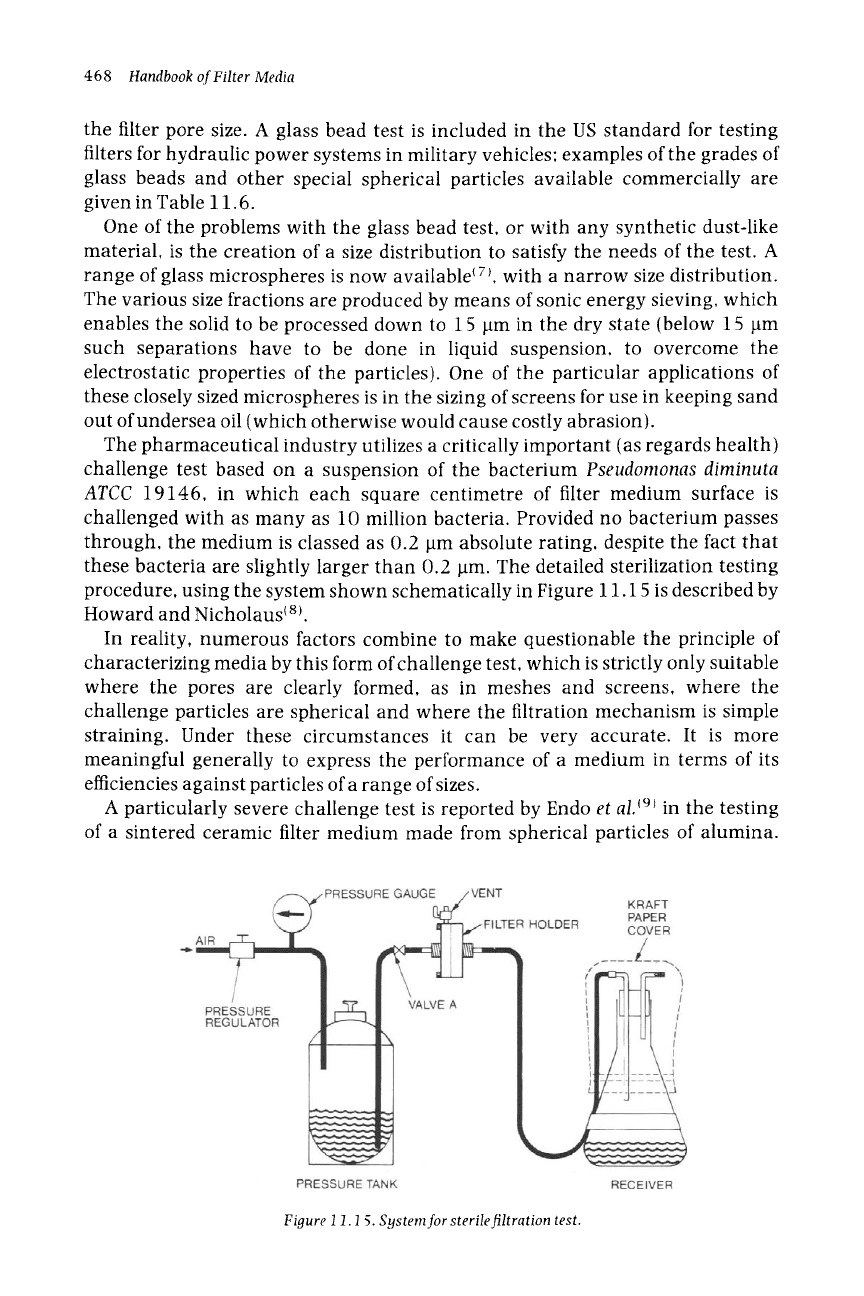
468
Handbook of Filter Media
the filter pore size. A glass bead test is included in the US standard for testing
filters for hydraulic power systems in military vehicles: examples of the grades of
glass beads and other special spherical particles available commercially are
given in Table 11.6.
One of the problems with the glass bead test, or with any synthetic dust-like
material, is the creation of a size distribution to satisfy the needs of the test. A
range of glass microspheres is now available ~ 7~ with a narrow size distribution.
The various size fractions are produced by means of sonic energy sieving, which
enables the solid to be processed down to 15 ~m in the dry state (below 15 pm
such separations have to be done in liquid suspension, to overcome the
electrostatic properties of the particles). One of the particular applications of
these closely sized microspheres is in the sizing of screens for use in keeping sand
out of undersea oil (which otherwise would cause costly abrasion).
The pharmaceutical industry utilizes a critically important (as regards health)
challenge test based on a suspension of the bacterium
Pseudomonas diminuta
ATCC
19146, in which each square centimetre of filter medium surface is
challenged with as many as 10 million bacteria. Provided no bacterium passes
through, the medium is classed as 0.2 lam absolute rating, despite the fact that
these bacteria are slightly larger than 0.2 pm. The detailed sterilization testing
procedure, using the system shown schematically in Figure 11.15 is described by
Howard and Nicholaus i 8).
In reality, numerous factors combine to make questionable the principle of
characterizing media by this form of challenge test, which is strictly only suitable
where the pores are clearly formed, as in meshes and screens, where the
challenge particles are spherical and where the filtration mechanism is simple
straining. Under these circumstances it can be very accurate. It is more
meaningful generally to express the performance of a medium in terms of its
efficiencies against particles of a range of sizes.
A particularly severe challenge test is reported by Endo
et al. ~9~
in the testing
of a sintered ceramic filter medium made from spherical particles of alumina.
Figure 11.15. System for sterile filtration test.

Table 11.6 Examples of highly graded spherical particles a
Description Size range Grades
Certified standards
Polystyrene 20-900 nm 26
nanospheres
Polymer 1 .()-160/am 26
microspheres 200-1 ()()0/am 10
Silica (). 5-1.6/am 4
microspheres
Borosilicate glass 2-20/am 6
microspheres
Soda-lime glass l. 5-2()()()/am 30
microspheres
Research
microspheres
Polystyrene latex 0.028- 3.7/am 42
Polystyrene DVB d 3.2-220/am 15
Examples
Certified mean
State
1% in water
0.2-5% in water
Dry spheres
2.()% in water
Dry spheres
Dry spheres
Dry spheres
Nominal size
(/am)
diameter (/am)
" Duke Scientific Corporation.
b SD=standard deviation.
': CV=coefficient of variance.
d DVB=cross-linked with 4-8% ofdivinylbenzene.
Size uniformity
SD b
5.3
0.010
7.5
0.02 jam
0.04/am
1. ()/am
1.7/am
0.9/am
22.7/am
Dry spheres
20
100
1
.()
200
0.5
1.6
2
20
1.5
75O
Mean
diameter(#m)
O.028
0.652
3.2
220
19_+1.5
102_+3
O.99-+0.02
202+4.0
().46_+().()3
1.57-+0,06
2.5+O. 5
20.2+1.4
2.1 +O.5
756+23
0.0031
0.0048/am
1.4/am
16.5/am
CV c
7.5%
1.0%
3.7
4.3 %
2.5
%
4()%
8.4%
43 %
3.0
11%
0.7%
43%
7.5"/0
r~
p..,.
p..,.
e~
e~
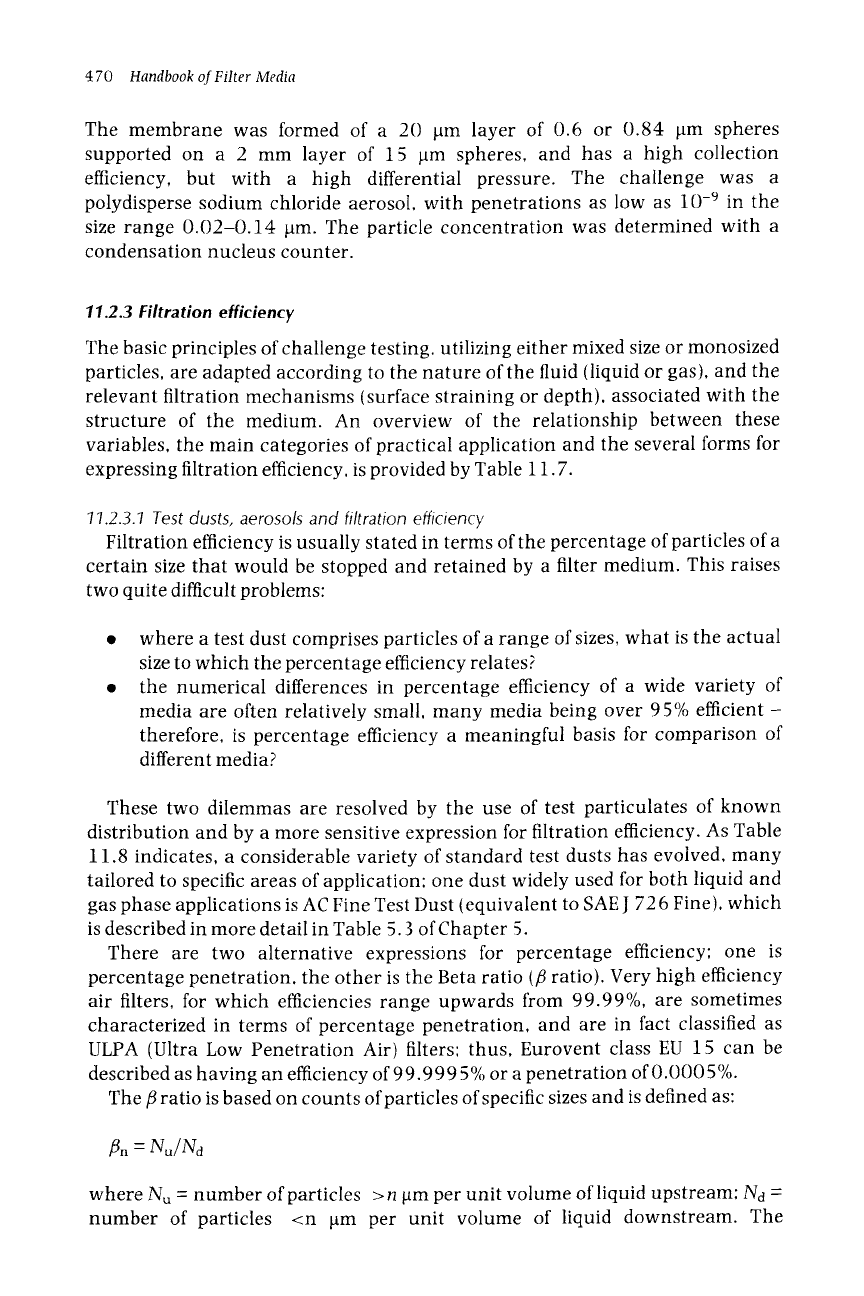
470
Handbook of Filter Media
The membrane was formed of a 20 l~m layer of 0.6 or 0.84 ~m spheres
supported on a 2 mm layer of 1:3 ~tm spheres, and has a high collection
efficiency, but with a high differential pressure. The challenge was a
polydisperse sodium chloride aerosol, with penetrations as low as 10 -9 in the
size range 0.02-0.14 ~m. The particle concentration was determined with a
condensation nucleus counter.
11.2.3 Filtration
efficiency
The basic principles of challenge testing, utilizing either mixed size or monosized
particles, are adapted according to the nature of the fluid (liquid or gas), and the
relevant filtration mechanisms (surface straining or depth), associated with the
structure of the medium. An overview of the relationship between these
variables, the main categories of practical application and the several forms for
expressing filtration efficiency, is provided by Table 11.7.
11.2.3.7 Test dusts, aerosols and filtration efficiency
Filtration efficiency is usually stated in terms of the percentage of particles of a
certain size that would be stopped and retained by a filter medium. This raises
two quite difficult problems:
where a test dust comprises particles of a range of sizes, what is the actual
size to which the percentage efficiency relates?
the numerical differences in percentage efficiency of a wide variety of
media are often relatively small, many media being over 95% efficient-
therefore, is percentage efficiency a meaningful basis for comparison of
different media?
These two dilemmas are resolved by the use of test particulates of known
distribution and by a more sensitive expression for filtration efficiency. As Table
11.8 indicates, a considerable variety of standard test dusts has evolved, many
tailored to specific areas of application: one dust widely used for both liquid and
gas phase applications is AC Fine Test Dust (equivalent to SAE J 726 Fine), which
is described in more detail in Table 5.3 of Chapter .5.
There are two alternative expressions for percentage efficiency: one is
percentage penetration, the other is the Beta ratio (fl ratio). Very high efficiency
air filters, for which efflciencies range upwards from 99.99%, are sometimes
characterized in terms of percentage penetration, and are in fact classified as
ULPA (Ultra Low Penetration Air) filters: thus, Eurovent class EU 15 can be
described as having an efficiency of 99.9995 % or a penetration of 0.0005 %.
The fl ratio is based on counts of particles of specific sizes and is defined as:
~n-
nu/Nd
where Nu - number of particles >n ~m per unit volume of liquid upstream: Nd =
number of particles <n ~m per unit volume of liquid downstream. The

Table 11.7 Summary of challenge test and filtration efficiency categories
Fluid Particle size Comments Test
variables
Efficiency expression
Application examples
Liquid 1. Mixed Most common Single pass or
multi-pass
Gas/air
2. Monosized Special cases Single pass
1. Mixed Air tilter standard Single pass
2. Monosized Air filter standard Single pass
1. Grade efficiency curves
2. Particle size for 98%
efficiency
3. fl factor
% efficiency for one size only
% weight retention
%
efficiency or % penetration
t'or one size only
Oeneral use
General use
Hydraulic power systems"
critical pharmaceuticals
Microorganism remowll
Air tilter for coarse and line
dusts
HEPA and ULPA air filters
"%
,%
,%
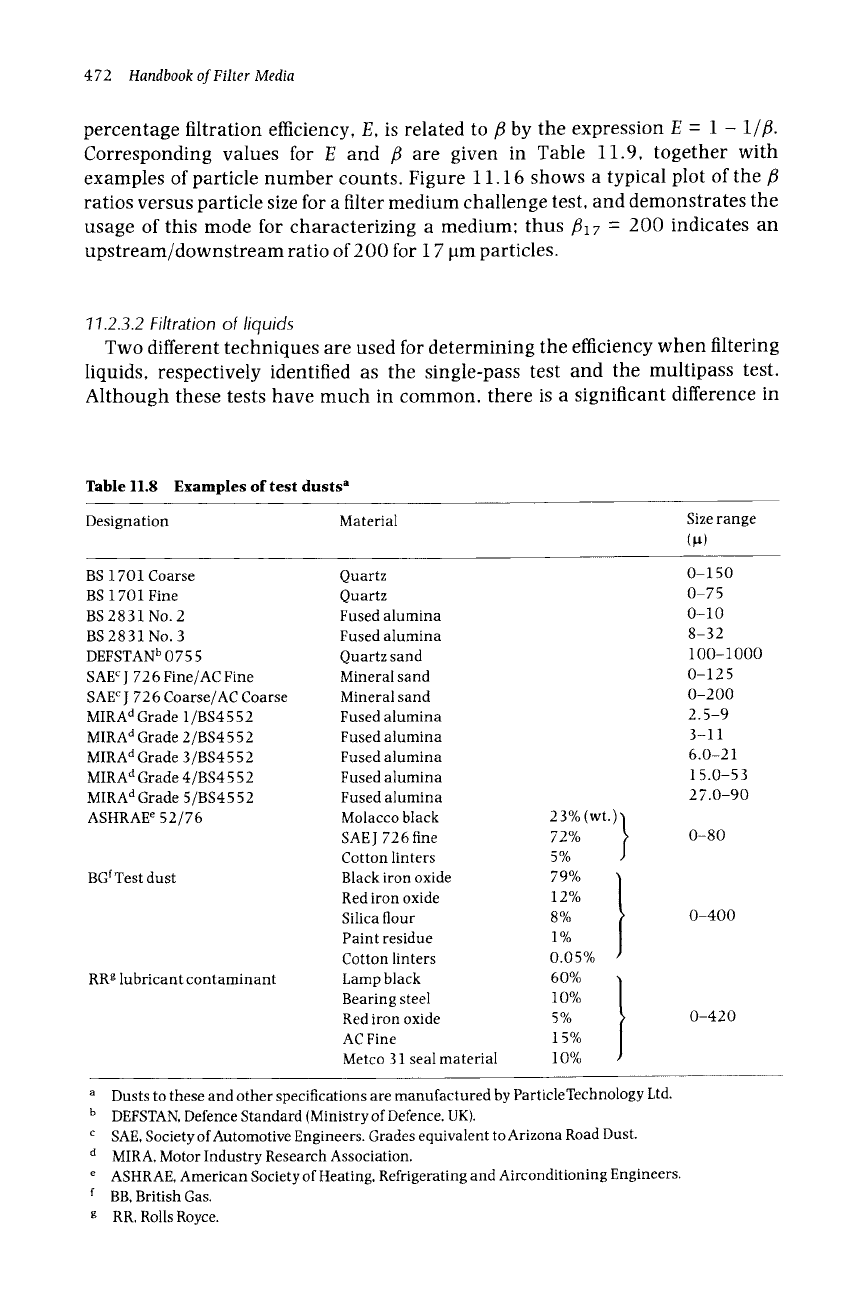
472
Handbook of Filter Media
percentage filtration efficiency, E, is related to fl by the expression E - 1 - l/ft.
Corresponding values for E and fl are given in Table 11.9, together with
examples of particle number counts. Figure 11.16 shows a typical plot of the fl
ratios versus particle size for a filter medium challenge test, and demonstrates the
usage of this mode for characterizing a medium; thus
fl17 -
200 indicates an
upstream/downstream ratio of 200 for 17 lam particles.
11.2.3.2 Filtration of liquids
Two different techniques are used for determining the efficiency when filtering
liquids, respectively identified as the single-pass test and the multipass test.
Although these tests have much in common, there is a significant difference in
Table 11.8 Examples of test dusts a
Designation Material Size range
(~)
BS 1701 Coarse Quartz O-150
BS 1701 Fine Quartz 0-75
BS 2831 No. 2 Fused alumina 0-10
BS 2831 No. 3 Fused alumina 8-32
DEFSTAN b 0755 Quartz sand 100-1000
SAE c J 726 Fine/AC Fine Mineral sand O-125
SAECj 726 Coarse/AC Coarse Mineral sand 0-200
MIRA d Grade 1/BS4552 Fused alumina 2.5-9
MIRA d Grade 2/BS4552 Fused alumina 3-11
MIRA a Grade 3/BS4552 Fused alumina 6.0-21
MIRA a Grade 4/BS4552 Fused alumina 15.0-53
MIRA a Grade 5/BS4552 Fused alumina 27.0-90
ASHRAE e 52/76 Molacco black 23% (wt.) /
SAEJ 726 fine 72% ~ 0-80
Cotton linters 5 %
BGf Test dust Black iron oxide 79%
Red iron oxide 12%
/
Silica flour 8% 0-400
Paint residue 1%
Cotton linters 0.05%
RRg lubricant contaminant Lamp black 60%
Bearing steel 10%
/
Red iron oxide 5% 0-420
AC Fine 15%
Metco 31 seal material 10%
a
Dusts to these and other specifications are manufactured by ParticleTechnology Ltd.
b DEFSTAN, Defence Standard (Ministry of Defence. UK).
c SAE, Society of Automotive Engineers. Grades equivalent toArizona Road Dust.
d MIRA, Motor Industry Research Association.
e ASHRAE, American Society of Heating, Refrigerating and Airconditioning Engineers.
f BB, British Gas.
g RR, Rolls Royce.
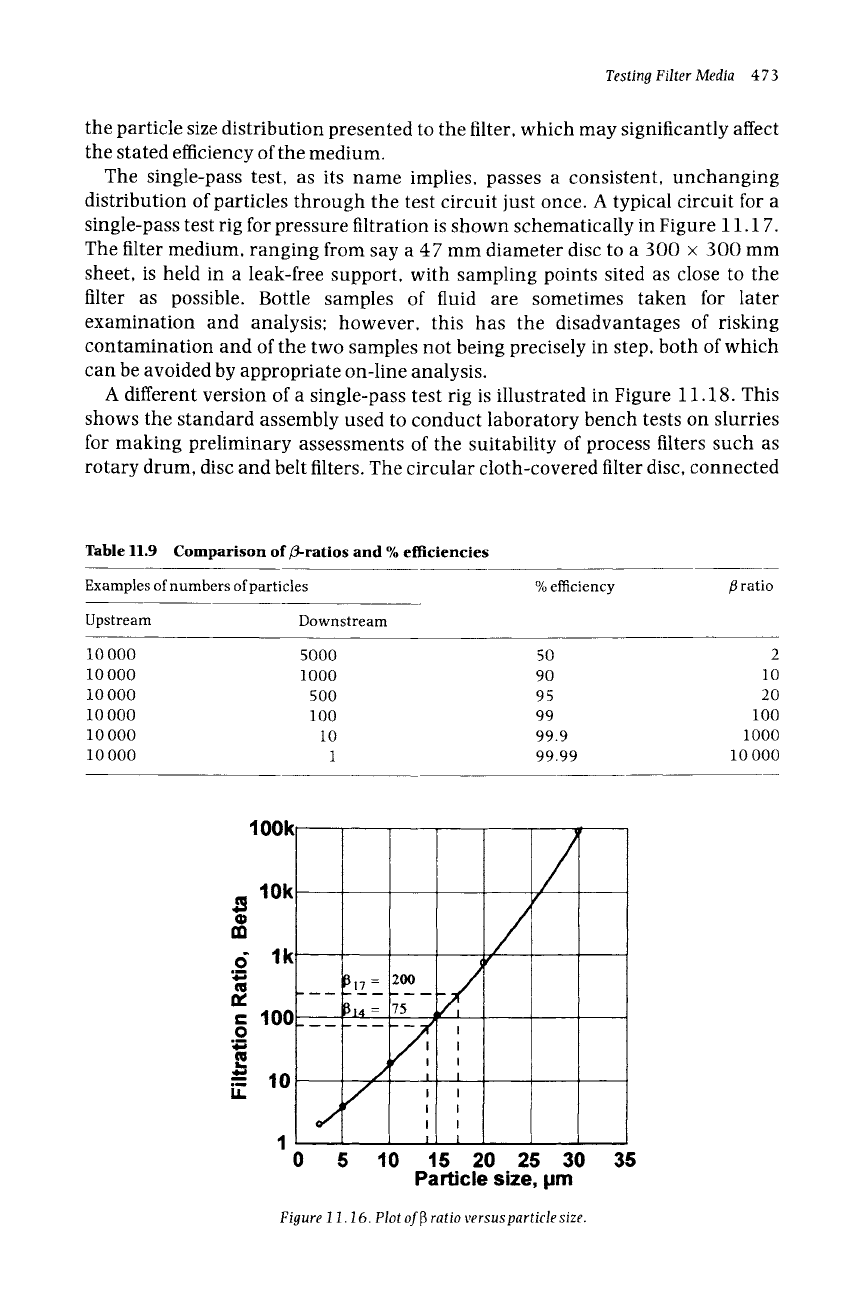
Testing Filter Media 473
the particle size distribution presented to the filter, which may significantly affect
the stated efficiency of the medium.
The single-pass test, as its name implies, passes a consistent, unchanging
distribution of particles through the test circuit just once. A typical circuit for a
single-pass test rig for pressure filtration is shown schematically in Figure 11.17.
The filter medium, ranging from say a 47 mm diameter disc to a 300 • 300 mm
sheet, is held in a leak-free support, with sampling points sited as close to the
filter as possible. Bottle samples of fluid are sometimes taken for later
examination and analysis; however, this has the disadvantages of risking
contamination and of the two samples not being precisely in step, both of which
can be avoided by appropriate on-line analysis.
A different version of a single-pass test rig is illustrated in Figure 11.18. This
shows the standard assembly used to conduct laboratory bench tests on slurries
for making preliminary assessments of the suitability of process filters such as
rotary drum, disc and belt filters. The circular cloth-covered filter disc, connected
Table 11.9
Comparison of ~-ratios and %
efficiencies
Examples of numbers of particles
Upstream Downstream
% efficiency 15 ratio
10 000 5000 50 2
10000 1000 90 10
10000 500 95 20
10000 100 99 100
10000 10 99.9 1000
10 000 1 99.99 10 000
lOOk
1Ok
0
m
,_~ lk -
/
GII 17=
tt
c 100 ~14--
75
~
/,,,,
.m ,2 '
10 ~
LL. .f~ ~ t
I I
0 5 10 15 20
25 30 35
/
/
/
v"
Particle size, pm
Figure 11.16. Plot off5 ratio versus particle size.

474
Handbook of Filter Media
to a flexible rubber hose, can be inverted into a container of slurry for a timed
period, such as 1 minute, so as to mimic the stage-wise cycle of these
continuous filters. Preliminary tests can be conducted with various types and
grades of filter cloth to permit initial selection in terms of criteria such as clarity
of filtrate, rate of filtration, and ease and completeness of discharge of the filter
cake. Full details of the experimental procedures are provided by Dahlstrom and
Silverblatt ~~
By contrast, the objective of the multipass test with the pressure filtration
circuit shown in Figures 11.19 and 11.20 is to challenge the filter with a
gradually increasing percentage of smaller particles: this is felt to be more
representative of real systems in which a fluid is recirculated repeatedly and
where larger particles are not only removed by filtration but are also being
ground down to smaller dimensions. This test was originally developed for
hydraulic oils but has become the basis of standards relating to other fluids such
as lubricating fluids and water: for example, the internal combustion engine lube
oil filter standard is ISO 4585. Therefore the multipass test, as defined by ISO
I Contaminant injection of test dust ]
carefully prepared in a separate system]
Test filter
EL ~ ~Particle LL~
"y' V Counter
,,, @
Figure 11.17. A typical single-pass test circuit for pressure filtration.
Figure 11.18. A basic set up for conducting leaf tests on slurries in relation to continuous vacuum filters.
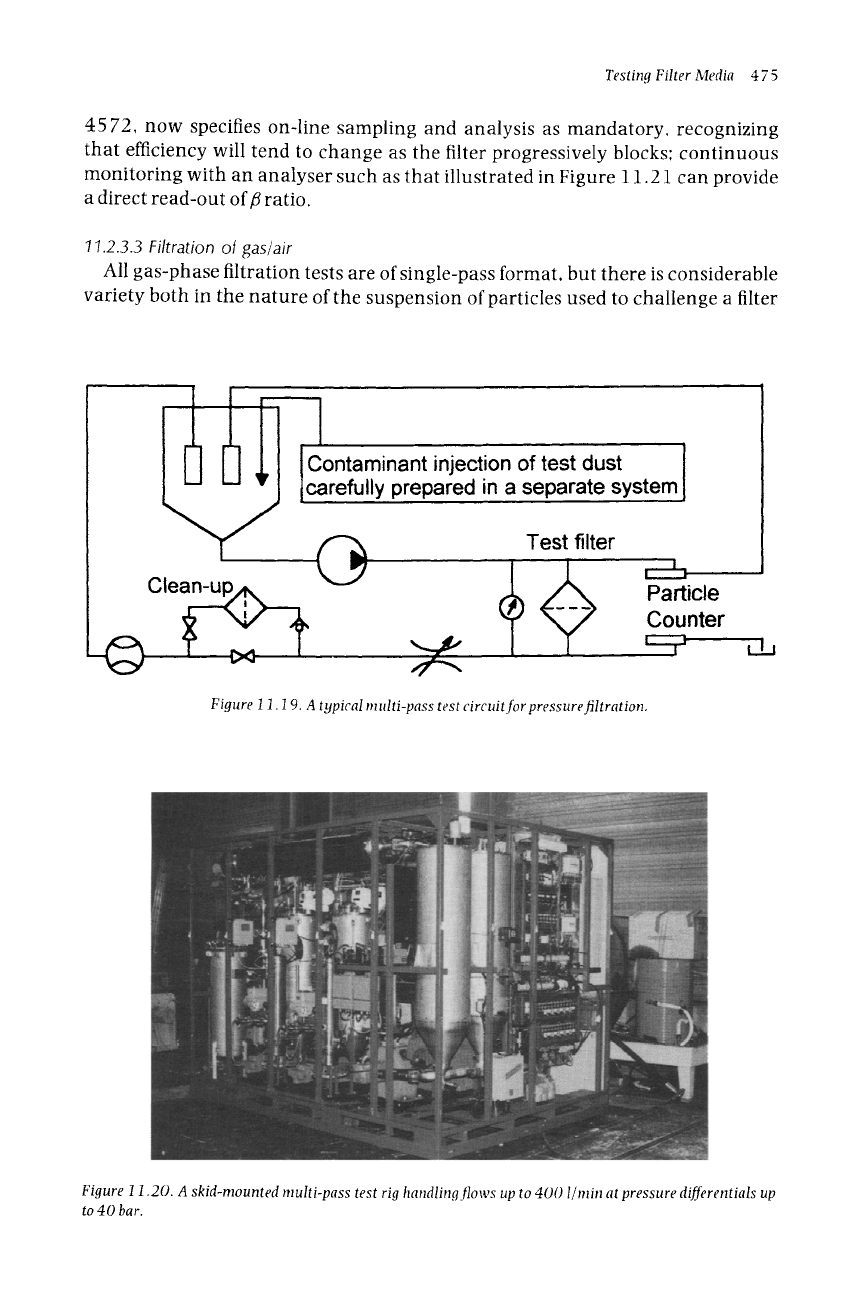
Testing Filter Media 475
4572, now specifies on-line sampling and analysis as mandatory, recognizing
that efficiency will tend to change as the filter progressively blocks" continuous
monitoring with an analyser such as that illustrated in Figure 11.21 can provide
a direct read-out of fl ratio.
11.2.3.3 Filtration
of
gas~air
All gas-phase filtration tests are of single-pass format, but there is considerable
variety both in the nature of the suspension of particles used to challenge a filter
, @
Contaminant injection of test dust
carefully prepared in a separate system
, ,
Test filter
t I~ ,
Particle
Counter
I1 ]t "
! Lb
Figure 11.19. A typical multi-pass test circuit for pressure filtration.
Figure 11.20. A skid-mounted multi-pass test rig handling flows up to 4001~rain at pressure differentials up
to 40 bar.
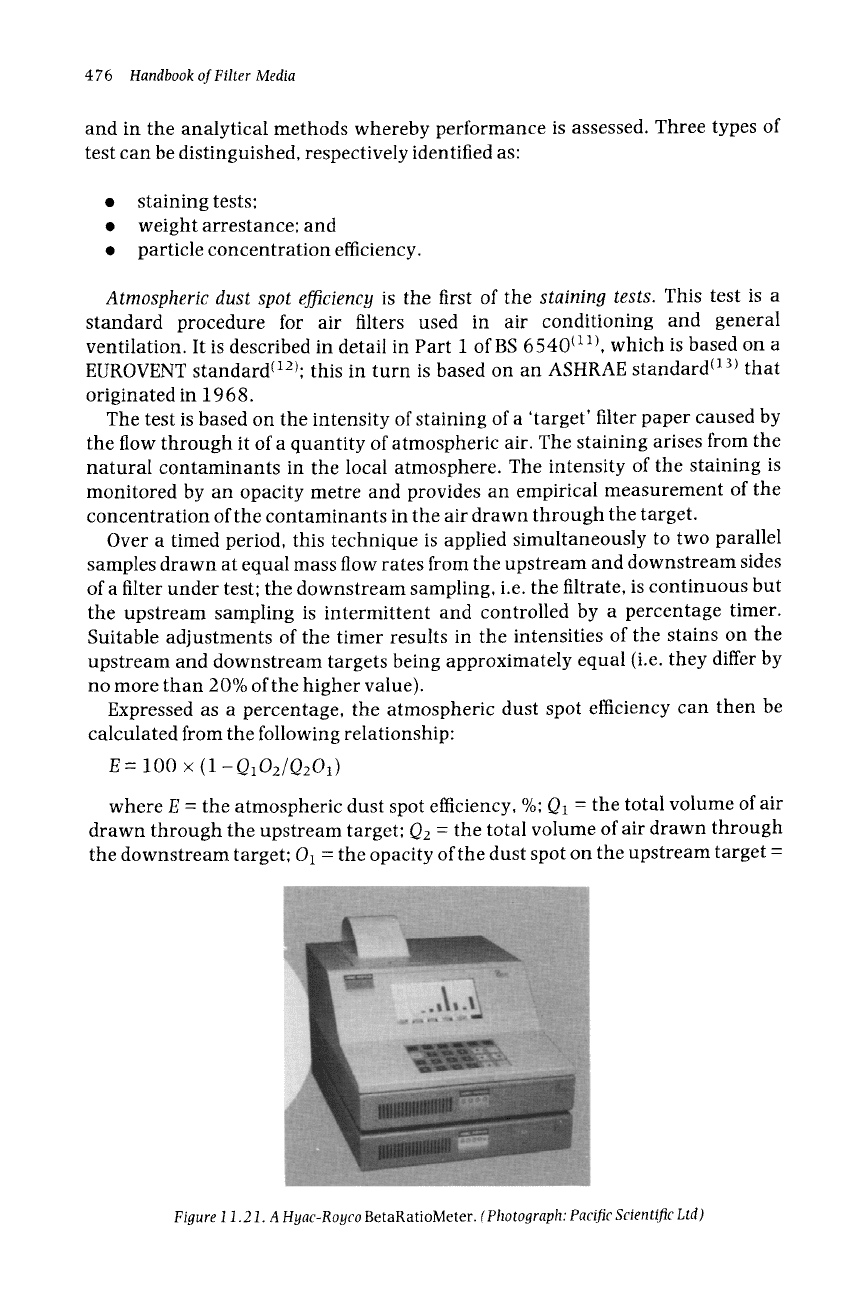
476 Handbook of Filter Media
and in the analytical methods whereby performance is assessed. Three types of
test can be distinguished, respectively identified as:
9 staining tests;
9 weightarrestance; and
9 particle concentration efficiency.
Atmospheric dust spot efficiency
is the first of the
staining tests.
This test is a
standard procedure for air filters used in air conditioning and general
ventilation. It is described in detail in Part 1 of BS 6540 tl 1~ which is based on a
EUROVENT standard~12~; this in turn is based on an ASHRAE standard ~13~ that
originated in 1968.
The test is based on the intensity of staining of a 'target' filter paper caused by
the flow through it of a quantity of atmospheric air. The staining arises from the
natural contaminants in the local atmosphere. The intensity of the staining is
monitored by an opacity metre and provides an empirical measurement of the
concentration of the contaminants in the air drawn through the target.
Over a timed period, this technique is applied simultaneously to two parallel
samples drawn at equal mass flow rates from the upstream and downstream sides
of a filter under test; the downstream sampling, i.e. the filtrate, is continuous but
the upstream sampling is intermittent and controlled by a percentage timer.
Suitable adjustments of the timer results in the intensities of the stains on the
upstream and downstream targets being approximately equal (i.e. they differ by
no more than 20% of the higher value).
Expressed as a percentage, the atmospheric dust spot efficiency can then be
calculated from the following relationship:
E = 100 x (1-Q102/Q201)
where E = the atmospheric dust spot efficiency, %; Ol = the total volume of air
drawn through the upstream target: O2 = the total volume of air drawn through
the downstream target: 01 = the opacity of the dust spot on the upstream target =
Figure 11.21. A Hyac-Royco
BetaRatioMeter.
(Photograph: Pacific Scientific Ltd)
